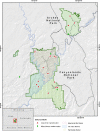Responses of wind erosion to climate-induced vegetation changes on the Colorado Plateau
- PMID: 21368143
- PMCID: PMC3053991
- DOI: 10.1073/pnas.1014947108
Responses of wind erosion to climate-induced vegetation changes on the Colorado Plateau
Abstract
Projected increases in aridity throughout the southwestern United States due to anthropogenic climate change will likely cause reductions in perennial vegetation cover, which leaves soil surfaces exposed to erosion. Accelerated rates of dust emission from wind erosion have large implications for ecosystems and human well-being, yet there is poor understanding of the sources and magnitude of dust emission in a hotter and drier climate. Here we use a two-stage approach to compare the susceptibility of grasslands and three different shrublands to wind erosion on the Colorado Plateau and demonstrate how climate can indirectly moderate the magnitude of aeolian sediment flux through different responses of dominant plants in these communities. First, using results from 20 y of vegetation monitoring, we found perennial grass cover in grasslands declined with increasing mean annual temperature in the previous year, whereas shrub cover in shrublands either showed no change or declined as temperature increased, depending on the species. Second, we used these vegetation monitoring results and measurements of soil stability as inputs into a field-validated wind erosion model and found that declines in perennial vegetation cover coupled with disturbance to biological soil crust resulted in an exponential increase in modeled aeolian sediment flux. Thus the effects of increased temperature on perennial plant cover and the correlation of declining plant cover with increased aeolian flux strongly suggest that sustained drought conditions across the southwest will accelerate the likelihood of dust production in the future on disturbed soil surfaces.
Conflict of interest statement
The authors declare no conflict of interest.
Figures





References
-
- Seager R, et al. Model projections of an imminent transition to a more arid climate in Southwestern North America. Science. 2007;316:1181–1184. - PubMed
-
- Sokolik I, Toon OB. Incorporation of mineralogical composition into models of the radiative properties of mineral aerosol from UV to IR wavelengths. J Geo Res. 1999;104:9423–9444.
-
- Piketh SJ, Tyson PD, Steffen W. Aeolian transport from southern Africa and iron fertilization of marine biota in the south Indian Ocean. S Afr J Sci. 2000;96:244–246.
Publication types
MeSH terms
LinkOut - more resources
Full Text Sources

